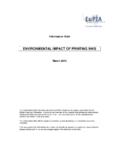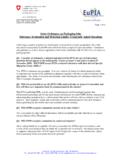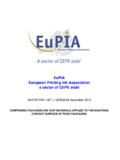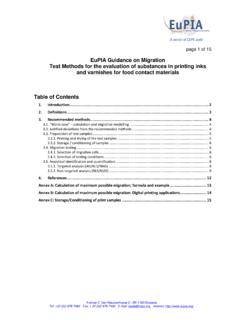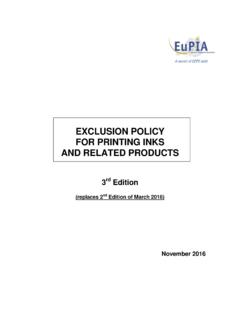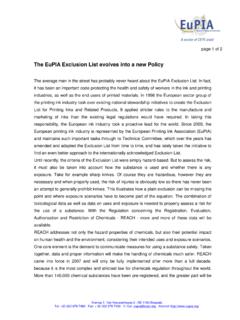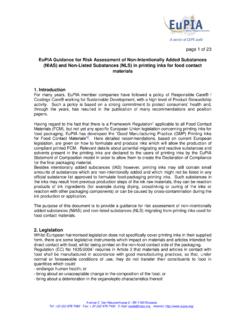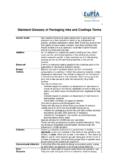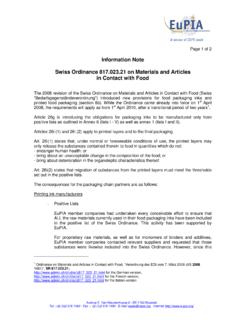Transcription of SWISS ORDINANCE ON MATERIALS AND ARTICLES …
1 Page 1 of 5. SWISS ORDINANCE ON MATERIALS AND ARTICLES . IN CONTACT WITH FOOD (SR ). Permitted Substances for Packaging Inks Questions & Answers The SWISS Federal Department of Home Affairs (FDHA) issued a revised version of the ORDINANCE on MATERIALS and ARTICLES (SR ), which came into force on 1st May 2017. Section 12 sets out the provisions relating to printing inks applied on the non-food contact surface of food contact MATERIALS (FCM) ( non-direct food contact FCM inks , non-DFC FCM inks ). Article 35 of this section details the requirement that only permitted substances should be used in the manufacture of Inks for Food Contact MATERIALS . Permitted Substances are defined as those which are listed in Annex 2 and in Annex 10. A transition period of four years applies to the section 12, as laid down in Article 95 (2). of the superordinate Lebensmittel- und Gebrauchsgegenst ndeverordnung (LGV) SR. As this piece of legislation is quite complex and can be prone to misinterpretation, the following guidance to addressing the most frequently posed questions, according to the understanding of EuPIA, is provided.
2 Please note that this guidance is provided in good faith and should not be considered as a legally validated position. Question 1. Is it true that Substances listed as B status' (unevaluated) in the individual substance lists cannot be used in non-DFC FCM inks? No, this statement is incorrect. Substances listed as B status' can be used, providing that the following requirements are met: the substances must not be classified as mutagenic', carcinogenic' or toxic to reproduction' (CMR substances) of category 1A, 1B or 2 in accordance with the criteria set out in Art. 6 of the ORDINANCE on Protection against Dangerous Substances and Preparations (ChemO). Avenue E. Van Nieuwenhuyse 6 - BE-1160 Brussels Tel: +32 (0)2 676 7480 - Fax: + 32 (0)2 676 7490 - E-mail: - Internet: Page 2 of 5. the migration of the substance into food or food simulant shall not be detectable measured with statistical certainty by a method of analysis with a limit of detection of mg/kg.
3 There are substances listed as B status' which may not be used as such as components of non-DFC inks; these are monomers or starting substances which are used by the raw material manufacturers upstream of the printing ink industry to produce polymeric substances which are then used in the manufacture of non-DFC inks. These substances are listed with the following restriction in column 9 of annex 10: Only to be used as a monomer or a starting substance for the preparation of polymeric substances'. Question 2. Does the transition period of four years also apply to the SMLs shown in Annex 10? The FSVO confirmed that the transition period of four years does not only relate to compositional requirements, labelling and advertising, but also to the specific migration limits. Question 3. Is there a requirement for the printing ink itself to comply with the SML's and QM's shown in the ORDINANCE ? No. The SML's and QM's apply to the individual substances present in the final food contact article ( the packaging) of which the dried printed ink layer is a component.
4 Question 4. If a substance or substances is/are listed in the ORDINANCE , does it mean that non- DFC FCM inks using these substances are safe? No. Listing on the ORDINANCE simply provides verification that the substance may be used in the manufacture of non-DFC FCM inks. To ensure safety according to the law, in end-use the migration limit(s) applicable to the substance(s) must not be exceeded and Good Manufacturing Practices (GMP) for printing inks manufacturing and printing must be used. Avenue E. Van Nieuwenhuyse 6 - BE-1160 Brussels Tel: +32 (0)2 676 7480 - Fax: + 32 (0)2 676 7490 - E-mail: - Internet: Page 3 of 5. Question 5. Are substances listed as A' status the good' ones and those listed in B' status the bad' ones? No. Substances listed as B' status are not necessarily bad' but remain unevaluated. Available toxicological and migration data may not have been considered by EFSA or other regulatory bodies due to the fact that they have not been previously used in regulated food contact MATERIALS such as food contact plastics.
5 B' status can also mean that there is insufficient data currently available for the substance and as a result an assessment cannot yet be made or, as the substance has never been petitioned for use in food contact MATERIALS , no toxicological data is available. Question 6. If new technologies (substances) are developed, will they automatically be considered a high risk resulting in related substances being listed as B' status? No. Applications for inclusion of any new substance into the ORDINANCE must be supported by a dossier of toxicological and migratory information. If the data is found to be sufficient, a limit for migration of that substance will be set, the new substance will be added to the correct substance list and it will be given A' status (evaluated). If the data is insufficient, the substance will be given B' status (unevaluated), the migration limit of mg/kg (10 ppb) will apply for the substance and additional information will be requested.
6 New substances may also be given B' status (unevaluated) if the initial dossier of submitted data indicates that there is no migration. In such cases the SWISS authorities may wish to run confirmatory tests before the substance is granted A' status (evaluated). Furthermore, if the new technology involves the use of substances which already have evaluation data, such substances may already be listed in the lists in the ORDINANCE with A' (evaluated) status. They will not necessarily be B' status ones. Question 7. Will the ORDINANCE restrict new developments in printing inks? Possibly yes. However in the course of the REACH registration process toxicological data gaps for many substances will be filled. Avenue E. Van Nieuwenhuyse 6 - BE-1160 Brussels Tel: +32 (0)2 676 7480 - Fax: + 32 (0)2 676 7490 - E-mail: - Internet: Page 4 of 5. Question 8. Will new technologies see long delays to full implementation? Possibly yes, some new technologies could be delayed if new, unevaluated substances are to be used.
7 Before such substances can be used, the required toxicological evaluation will have to be completed, the dossier of information submitted for evaluation, and approval obtained. Question 9. Does the ORDINANCE apply to every food contact article? Yes the ORDINANCE applies to every food contact article. The list of permitted substances in Annex 10 only applies, however, to printing inks for printing on the non- food contact side of MATERIALS that are in contact with foodstuffs. There are some other applications excluded, but not relevant for the purpose of this paper. Question 10. Will the ORDINANCE kill some ink technologies? There is a risk that this may happen, however this is clearly not the objective of the ORDINANCE . In extreme cases where substance manufacturers have no interest in developing toxicological dossiers for specific substances that are key to a particular technology, the consequence might be discontinuation of that technology.
8 Question 11. Will Non Governmental Organizations make use of the SWISS ORDINANCE ? Possibly yes the ORDINANCE is a public document and everyone with an interest will make use of it in whatever way they require. The ORDINANCE does however only apply to Switzerland and is only legally binding in Switzerland. Toxicological evaluations made by the SWISS authorities may not therefore be recognized by other national authorities or toxicologists. Question 12. Are there substances exempt from being listed? Some printing ink components are currently not required to be listed in Annex 10, such as polymers (if component monomers are listed), pigment additives and certain salts of Avenue E. Van Nieuwenhuyse 6 - BE-1160 Brussels Tel: +32 (0)2 676 7480 - Fax: + 32 (0)2 676 7490 - E-mail: - Internet: Page 5 of 5. listed acids. Similarly some application scenarios are also not covered by the ORDINANCE , where the packaging ink layer is in direct contact with the foodstuff.
9 It is not known whether such substances and applications will continue to be exempted , but EuPIA continues to have a close dialogue with FSVO regarding the future direction and scope of the ORDINANCE . Question 13. Who will submit new substances to the SWISS authorities? The manufacturers of new substances, to effect that the substances can be used by ink manufacturers as raw MATERIALS in the manufacture of food packaging inks. Question 14. Will the SWISS ORDINANCE have an impact on legislation in other countries outside of Switzerland? Not directly. The SWISS ORDINANCE has no legal status outside of Switzerland. However the European Commission may consider the ORDINANCE when further developing EU. food contact legislation. Question 15. How will Non Intentionally Added Substances' (NIAS) be handled? This is not specifically addressed by the ORDINANCE . However, any transfer of substances from food contact material into food may only occur at levels that do not endanger human health, as stipulated by Article 49 of the superordinate Lebensmittel- und Gebrauchsgegenst ndeverordnung (LGV) SR This general requirement includes NIAS.
10 In order to meet this requirement, EuPIA members will follow the EuPIA. Guidance for Risk Assessment of Non-Intentionally Added Substances (NIAS) and Non Listed Substances (NLS) in printing inks for food contact MATERIALS . EuPIA, 15 June 2010. 1st revision 08 February 2011. 2nd revision 18 June 2015. 3rd revision 08 June 2017. 4th revision 05 October 2017. Avenue E. Van Nieuwenhuyse 6 - BE-1160 Brussels Tel: +32 (0)2 676 7480 - Fax: + 32 (0)2 676 7490 - E-mail: - Internet.
